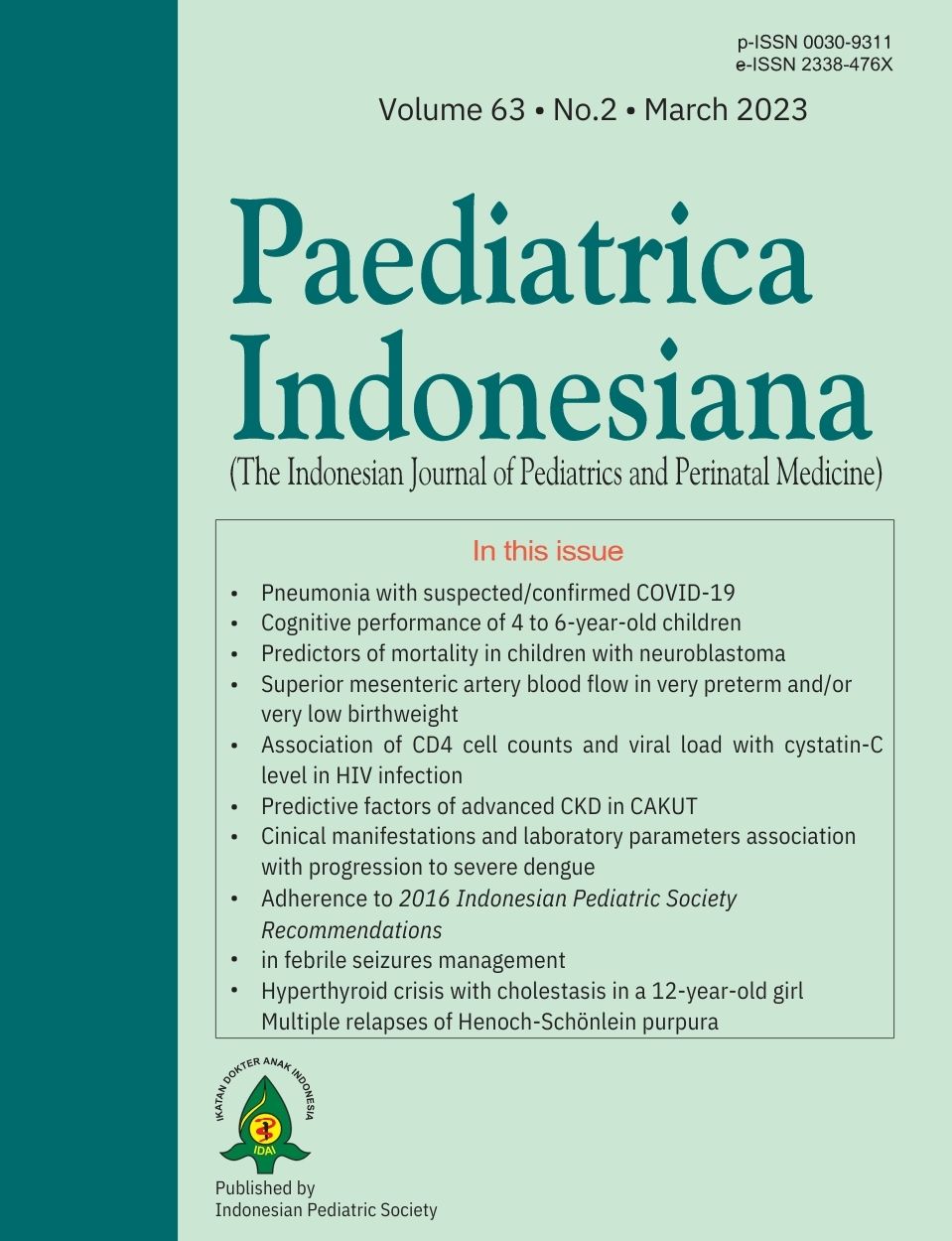Predictive factors of advanced chronic kidney disease in children with congenital anomalies of kidney and urinary tract
Abstract
Background Congenital anomalies of the kidney and urinary tract (CAKUT) are the most common cause of chronic kidney disease (CKD) in children. Delayed diagnosis of CAKUT due to lack of universal screening (such as prenatal ultrasound screening or postnatal ultrasound screening in neonates with risk of CAKUT) has led to more cases of advanced CKD in children. CKD has high morbidity and mortality, and early detection is required to prevent the progression of CKD.
Objective To determine the factors that predict the development of advanced CKD in children with CAKUT.
Methods This retrospective cohort study included children with CAKUT at Dr. Sardjito Hospital, Yogyakarta, Indonesia from January 2016 to February 2021. Patients who were diagnosed with CAKUT were followed up to 5 years or until the onset of advanced CKD. Advanced CKD was defined as a decreased estimated glomerular filtration rate (eGFR) of less than 30mL/min/1.73m2 based on the revised Schwartz formula. CKD progression-free survival was determined with Kaplan-Meier and Cox regression analyses.
Results Among 62 subjects with CAKUT, 7 (11.3%) subjects progressed to advanced CKD. The mean time of advanced CKD progression was 52.2 (95%CI 46.9 to 57.5) months. The overall incidence rate was 22 per 1,000 person-years. Based on Kaplan-Meier analysis, children with eGFR <60 mL/min/1.73m2 at the time of diagnosis had more rapid progression to advanced CKD than patients with eGFR ?60 mL/min/1.73m2 [40.2 (95%CI 33.4 to 46.6) months vs. 58.2 95%CI 46.9 to 57.5) months; P=0.02, respectively].
Conclusion Reduced eGFR at the time of diagnosis showed rapid progression to advanced CKD.
References
2. Rosenblum ND. Congenital anomalies of the kidney and urinary tract: an overview. In: Barakat AJ, Rushton HG, editors. Congenital anomalies of the kidney and urinary tract. Washington, DC: Springer; 2016. p. 1–14.
3. Ramayani OR, Ritarwan K, Eyanoer PC, Siregar R, Ramayati R. Renal survival analysis of CAKUT and outcomes in chronic kidney disease. Curr Pediatr Res. 2017;21:691–5.
4. Kumar BH, Krishnamurthy S, Chandrasekaran V, Jindal B, Ananthakrishnan R. Clinical spectrum of congenital anomalies of kidney and urinary tract in children. Indian Pediatr. 2019;56:566–70. DOI: https://doi.org/10.1007/s13312-019-1556-9
5. Tain YL, Luh H, Lin CY, Hsu CN. Incidence and risks of congenital anomalies of kidney and urinary tract in newborns a population-based case-control study in Taiwan. Medicine (Baltimore). 2016;95:1-7. DOI: https://doi.org/10.1097/MD.0000000000002659
6. Kula AJ, Somers MJG, American Society of Pediatric Nephrology. Children with CKD are not little adults with CKD pediatric considerations for the Advancing American Kidney Health Initiative. Clin J Am Soc Nephrol. 2021;16:470–2. DOI: https://doi.org/1 0.2215/CJN.11540720
7. Winnicki E, McCulloch CE, Mitsnefes MM, Furth SL, Warady BA, Ku E. Use of the kidney failure risk equation to determine the risk of progression to end-stage renal disease in children with chronic kidney disease. JAMA Pediatr. 2018;172:174–80. DOI: https://doi.org/10.1001/jamapediatrics.2017.4083
8. Becherucci F, Roperto RM, Materassi M, Romagnani P. Chronic kidney disease in children. Clin Kidney J Adv. 2016;9:583-91. DOI: https://doi.org/10.1093/ckj/sfw047
9. McDonald SP, Craig JC, Australian and New Zealand Paediatric Nephrology Association. Long-term survival of children with end-stage renal disease. N Engl J Med. 2004;350:2654–62. DOI: https://doi.org/10.1056/nejmoa031643
10. Isert S, Müller D, Thumfart J. Factors associated with the development of chronic kidney disease in children with congenital anomalies of the kidney and urinary tract. Front Pediatr. 2020;8:298. DOI: https://doi.org/10.3389/fped.2020.00298
11. Fathallah-Shaykh SA, Flynn JT, Pierce CB, Abraham AG, Blydt-Hansen TD, Massengill SF, et al. Progression of pediatric CKD of nonglomerular origin in the CKiD cohort. Clin J Am Soc Nephrol. 2015;10:571–7. DOI: https://doi.org/10.2215/CJN.07480714
12. Ramayani OR, Djas Y, Ramayati R, Eyanoer PC, Ritarwan K. Models predicting complication in congenital anomaly kidney and urinary tract. Curr Pediatr Res. 2019;23:71–6.
13. Soliman NA, Ali RI, Ghobrial EE, Habib EI, Ziada AM. Pattern of clinical presentation of congenital anomalies of the kidney and urinary tract among infants and children. Nephrology. 2015;20:413–8.
14. Sekarwana N, Pabuti A. Penyakit ginjal kronik. In: Buku ajar nefrologi anak. 3rd ed. Jakarta: Badan Penerbit Ikatan Dokter Anak Indonesia; 2017. p. 609–24.
15. Chunnaedy S, Pardede SO, Djer MM. Karakteristik dan kesintasan penyakit ginjal kronik stadium 3 dan 4 pada anak di Departemen Ilmu Kesehatan Anak FKUI-RSCM. Sari Pediatr. 2016;16:71. DOI: https://doi.org/10.14238/sp16.2.2014.71-8
16. Staples A, Wong C. Risk factors for progression of chronic kidney disease. Curr Opin Pediatr. 2010;22:161–9. DOI: https://doi.org/10.1097/MOP.0b013e328336ebb0
17. Hidayati EL, Trihono PP. Admission characteristics of pediatric chronic kidney disease. Paediatr Indones. 2011;51:192-7. DOI: https://doi.org/10.14238/pi51.4.2011.192-7
18. Boubaker A, Prior JO, Meyrat B, Delaloye AB, McAleer IM, Frey P. Unilateral ureteropelvic junction obstruction in children: long-term followup after unilateral pyeloplasty. J Urol. 2003;170:575–9. DOI: https://doi.org/10.1097/01.ju.0000071480.83890.36
19. Kamath N, Iyengar A, George N, Luyckx VA. Risk factors and rate of progression of CKD in children. Kidney Int Rep. 2019;4:1472–7. DOI: https://doi.org/10.1016/j.ekir.2019.06.004.
20. Chang CC, Su MJ, Ho JL, Tsai YH, Tsai WT, Lee SJ, et al. The efficacy of semi-quantitative urine protein-to-creatinine (P/C) ratio for the detection of significant proteinuria in urine specimens in health screening settings. Springerplus. 2016;5:1791. DOI: https://doi.org/10.1186/s40064-016-3389-5.
Copyright (c) 2023 Dea Puspitarini, Elisabeth Siti Herini, Cahya Dewi Satria, Kristia Hermawan

This work is licensed under a Creative Commons Attribution-NonCommercial-ShareAlike 4.0 International License.
Authors who publish with this journal agree to the following terms:
Authors retain copyright and grant the journal right of first publication with the work simultaneously licensed under a Creative Commons Attribution License that allows others to share the work with an acknowledgement of the work's authorship and initial publication in this journal.
Authors are able to enter into separate, additional contractual arrangements for the non-exclusive distribution of the journal's published version of the work (e.g., post it to an institutional repository or publish it in a book), with an acknowledgement of its initial publication in this journal.
Accepted 2023-04-11
Published 2023-04-11













